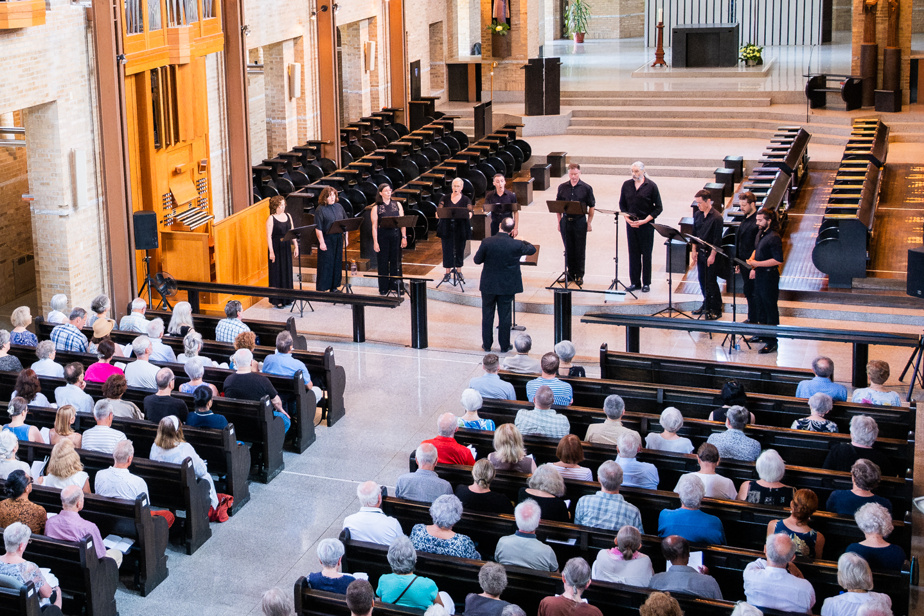It’s not every day that you attend a concert in a Benedictine monastery. It’s not every day that we experience a moment of grace like the concert of the Studio de musique contemporaine de Montréal (SMAM) on Saturday afternoon given as part of the Orford Music Festival.
The abbey church of the monastery of Saint-Benoît-du-Lac, an architectural jewel set in the hollow of the two northern branches of Lake Memphremagog, in Estrie, has some 400 places, which were all occupied. Not to hear the immemorial chanting of the monks, but that of ten professional singers handpicked “for the purity and clarity of their voices”, as specified in the program, which unfortunately did not give the names of these true singing athletes. .

PHOTO CHARLES WILLIAM PELLETIER, THE PRESS
The head of the Montreal Early Music Studio, Andrew McAnerney
Arranged in a semi-circle at the entrance to the choir of monks in front of their leader Andrew McAnerney, they proposed an anthology of pieces from the Renaissance (between the years 1460 and 1560 in this case) having as common point to commemorate the disappearance great musical figures of the time.
We thus have two tributes – from the Flemings Benedictus Appenzeller and Hieronymus Vinders – to Josquin des Prés, who had done the same for Ockeghem, and the latter for Binchois…
The title of the concert (sweet memory) is itself inspired by a famous song by Pierre Sandrin, which inspired a complete mass at Cipriano de Rore (we call this a parody mass), which closed the concert.
It would have been useful to have some explanatory notes in order to better understand the context of the composition of the works on the program, the text of which, in Latin, French or Italian, had fortunately been reproduced. That didn’t stop audiences from relishing – religiously – the 90 minutes of music, which also included four short motets by Toronto’s Stephanie Martin in honor of Healey Willan, father of Anglo-Canadian classical music.

PHOTO CHARLES WILLIAM PELLETIER, THE PRESS
The abbey church of the monastery of Saint-Benoît-du-Lac
No way to do otherwise with the ideal acoustics of the magnificent church designed 30 years ago by Montrealer Dan Hanganu. Even seated close to the singers as we were, the voices blended perfectly with each other, without taking away the independence of each of the desks (the pieces were in four or five voices, except O mors inevitabilis de Vinders, seven votes).
voice sculptor
Former member of the legendary Tallis Scholars, which we praised when they came to Bourgie Hall last fall, the Briton Andrew McAnerney took over the direction of the Montreal ensemble founded by Christopher Jackson in 1974 eight years ago. He confirmed on Saturday that he is a real voice sculptor.
Because singing this repertoire is not far from tightrope walking. However, almost never do we hear one of the singers break through.
The sopranos are just enough present, and the accuracy never fails (ah! those final chords!). Our only – tiny – reservations concern the sopranos, whose sound could sometimes have a bit of extra roundness, and the basses, which tend to somewhat cover certain highs.
The “instrument” thus fashioned by McAnerney is also capable of the greatest contrasts in nuances, such as this pianissimo lunar in Musae Jovis of Appenzeller or these strong-soft alternations in the Credo of the Missa Doulce memory of Rora. The rhythmic contrasts were also there, as we could hear with the performer Death, you were sorry for your sting of Ockeghem, followed by wood nymphs by Josquin des Prés, beautifully posed.
The ensemble ended this fascinating afternoon with theIn memoriam by Toronto’s Ruth Watson Henderson in tribute to choirmaster Elmer Iseler, a delicate piece sung to vowels.
The Orford Music Festival is in full swing until August 5.
